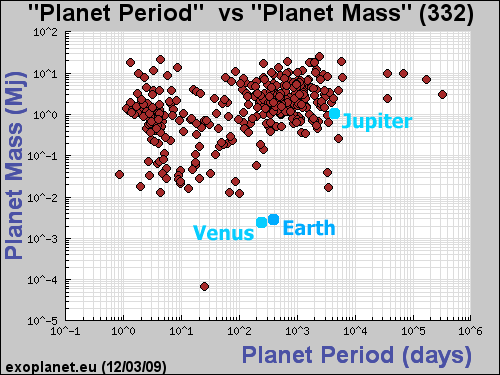One of the nice things about the Extrasolar Planets Encyclopedia, which I came across whilst writing about Kepler, is that you can produce plots which summarise the properties of all the extra-solar planets discovered so far. I was particularly interested in the plot below, of orbital period (in days) against mass (scaled relative to the mass of Jupiter), to which I’ve added Earth, Venus and Jupiter for reference.

In terms of mass, it’s clear that most of the planets discovered so far are big gas giants, on the scale of Jupiter or bigger, with a scattering of smaller gas giants and Super Earths. If, as I’ve argued before, this reflects the limits of our current detection technology, in the next few years Kepler and CoRoT should increase the number of points in this range, and below it (for those of you wondering about the ultra-small outlier, it’s orbiting a pulsar).
More interesting is the distribution of orbital periods, which is actually bimodal: there’s a cluster in the 1-10 day range, representing the ‘hot Jupiters’, and another, larger, cluster of gas giants with orbital periods of about 1-10 years, which Jupiter is just about on the edge of. It’s probably my fault for not paying enough attention, but I was genuinely unaware that so many of this latter type had been discovered: I was under the impression that almost all of the extra-solar planets discovered thus far were sun-skimming hot Jupiters, if only because they are much easier to detect. The fact that we’re detecting gas giants in a much more familiar place (when compared to our own galactic neck of the woods) is actually quite encouraging, and actually increases my confidence that we don’t need to chuck out the Copernican Principle just yet.
Update: for those in the comments who astutely pointed out that many of these planets have a much higher eccentricity than planets in our solar system (~0.05 on average), it turns out this may indeed be an issue:
“If Jupiter’s orbit around the sun was just a bit more eccentric (oblong), it would have scattered a lot of the material that delivered water to the Earth, kicking it out of the solar system instead,” [Sean Raymond, who has been modelling extra-solar planet formation] says. “The result would have been an Earth that had only 10 percent of the water it does now.”
Interestingly, the passage of “hot Jupiters” from the outer solar system where they form to their sun-skimming orbits, whilst disruptive to the formation of the rocky inner planets, does not preclude their survival.




Nice plan for content warnings on Mastodon and the Fediverse. Now you need a Mastodon/Fediverse button on this blog.